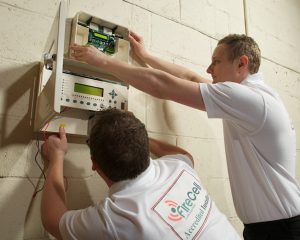FIRE ALARM AND INTRUDER ALARM SYSTEM MONITORING
The primary function of the Fire Alarm System is for early automatic detection of a fire which will set off an alarm that will alert all occupants and give them time to get to safety.
Fire Alarm System Monitoring
In the case of a fire every second counts and in buildings where occupants may become trapped, or for property protection, the Fire Alarm Control Panel can be set up to send a fire alarm signal to an Alarm Receiving Centre (ARC) who will escalate the alarm to the Fire & Rescue Services for immediate response.
The fire alarm systems must be serviced at least every 6 months and the fault and fire signal transmissions tested to make sure that, in the event of an emergency, help will be on its way without delay

Intruder Alarm System Monitoring
While the external Bell Box acts as a visible deterrent and the local audible warnings should attract attention of neighbours and passers-by to a break-in, many alarms may be unheard or ignored, giving an intruder time in your property to take your valuables.
Professional Intruder Alarms that are supplied and fitted by an accredited Installation Company can be connected to an Alarm Receiving Centre (ARC) who will react to “unconfirmed” and “confirmed” alarms for Police response.
An “unconfirmed” alarm is where one detector has been triggered. In this case the alarm will sound in the property and the ARC will notify authorised “keyholders” (people entrusted with keys and intruder alarm codes that can be at the property within 20 minutes).
A “confirmed” alarm is where 2 “events” occur within a short period of time (making it extremely likely that there is someone in the property and not just a false alarm). In this case the ARC will call keyholders and the Police who will respond as Level 1 (high priority) and rush to the property.
As the police cannot be called until there is a confirmed alarm, it is important that systems are designed to provide this in the early stages of a break in. It also reduces the risk of keyholders going to properties without the police, i.e. after an unconfirmed alarm, with criminals possibly present within or at the premises.
Intruder alarms also offer a “Hold Up” or “Panic” Alarm where the system can be put into alarm manually when it is unset. This requires 2 buttons to be pressed simultaneously (to reduce the possibility of a false alarm). When a hold up or panic alarm is triggered, the ARC will escalate this to the police and keyholders immediately, and their response cannot be cancelled.
It is particularly important that monitored systems are serviced, maintained and managed carefully as the Level 1 police response will be withdrawn if they are called to respond to 3 false alarms within a 12 month period. For this reason monitored systems need to have 2 service visits per year.
Alarm Transmission Systems (ATSs)
Monitoring using a “Standard “Digi” Signal Transmission Unit
This uses a digital signalling device that connects to the Alarm Receiving Centre (ARC) using a PSTN telephone line. The disadvantage of this type of signalling is that, if the telephone connection is lost, no alarms will be received by the ARC. It is likely that the current technology using DTMF (Dual Tone Multi Frequency dialling will mean that this will become obsolete as “virtual telephone networks” are rolled out across the country.
A monitored system should send out a test signal at least every 24 hours and, if the sgnal fails to get through then keyholders would be informed that there may be a fault on the line. On a standard telephone line this test signal is chargeable and can cost a significant amount of money every year.
Monitoring using a “Digi Air” Signal Transmission Unit
This uses a digital signalling device that connects to the Alarm Receiving Centre (ARC) using the GPRS (cellular) network and is a very useful alternative to using the telephone line. The GPRS path uses a “roaming SIM card” which will select the strongest network signal.
The cost of the SIM card and signalling are incorporated in the annual Servicing, Maintenance and Monitoring Contract so there are no additional charges for the regular test signals.
Monitoring using a “Dual Path” Signal Transmission Unit
This uses a signalling device that has a two signalling paths, a “primary” path and a “secondary” path so that if the primary signalling path is lost or blocked, signals will get through on the secondary path. In addition, if either path is lost or blocked, then the other path is used to alert keyholders that there is a problem with the signalling.
The signalling unit has connections for the PSTN line, a GPRS SIM card, and an Ethernet port. So there is a choice of landline, cellular and internet communications, making the system very secure and reliable.
The cost of the SIM card and signalling are incorporated in the annual Servicing, Maintenance and Monitoring Contract.
